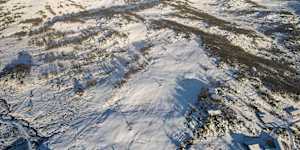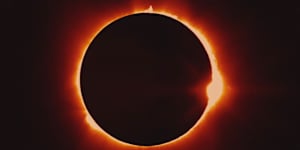Hopeful stargazers will shiver,however,as Sydney temperatures plunge to their coldest in six months and snow blankets parts of NSW over the weekend.

A dumping of snow fell on NSW’s Perisher ski resort on Wednesday,with more to come this weekend.Perisher
Friday night will hit lows of 9 degrees,the chilliest night since October. A blast of Antarctic air will dust the Blue Mountains with snow and make Sunday Sydney’s coldest day this year,based on Bureau of Meteorology measurements from Observatory Hill,with highs of 18 degrees.
The cold front moving up through South Australia and Victoria is bringing the coldest early May weather in three years to the southern states and will hit NSW by Sunday,Weatherzone meteorologist Maryam Al-Ansari said.
“[The cold front] will develop into a secondary low pressure in the Tasman Sea on Sunday. That’s going to add a lot of gusty south-westerly winds up the coast which is going to trigger a lot more rainfall and also snow for a lot of the ranges.
“It will be getting cold in Sydney,and it’s going to get very,very wet on Sunday,particularly in the evening,and there are chances of thunderstorms as well.”
Weatherzone predicts 15 millimetres of rain in Sydney on Sunday and a potential 50-millimetre lashing for the Shoalhaven area.
However,skies will be clear tonight for those keen to view the lunar eclipse and one of the brightest meteor showers visible from Australia this year.
The eclipse will start at 1.14am in Sydney as it’s caught in the Earth’s penumbra – the lighter part of the shadow cast by the planet.
The moon will miss the darkest point of the Earth’s shadow,the umbra,meaning it will dim to an eerie glow rather than completely black out. The peak of the eclipse will be at 3.22am.

The lunar eclipse is paired with the solar eclipse (pictured) that stunned viewers of the totality in Exmouth,Western Australia,last month.Nine News
A lunar eclipse always follows a solar eclipse by about a fortnight. The May 6 event shares its “eclipse season” with the hybrid solar eclipse that.
The pre-dawn timing of the lunar eclipse coincides with the peak of the annual Eta Aquariid meteor shower.
The meteors originate from a band of debris cast off from Halley’s Comet. The Earth passes through the comet’s dusty orbit twice a year,in May and October,which generates the annual light shows. (The October shower is called the Orionids.)
During the peak of the shower,between Friday and Sunday,stargazers will spot between eight and 30 meteors leaving incandescent trails in the sky as celestial debris tears through the atmosphere at 66 kilometres per second,NASA says.
Most meteor showers are best viewed from the northern hemisphere,but Eta Aquariid is the second-brightest shower visible from southern skies,astronomers said.
Look east for the best show and keep an eye out for “Earth grazers”,which are likely to occur from 1.30am. They are meteors that hit the earth’s atmosphere at a shallow angle,casting fiery trails that can split the entire sky from one horizon to the other.
Liam Mannix’s Examine newsletter explains and analyses science with a rigorous focus on the evidence..